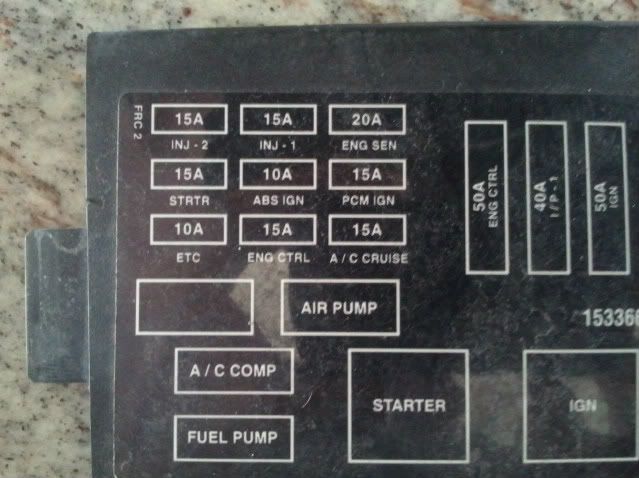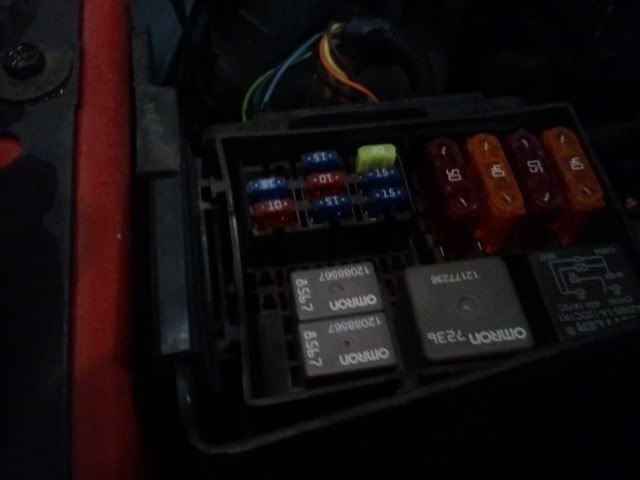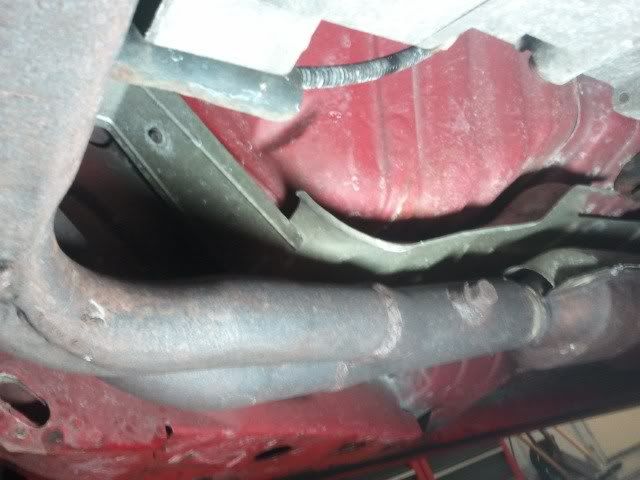I have a basically stock 2000 Firebird V6 (3.8 litre or 3800) with a manual transmission and about 92,000 miles. For months I have been trying to fix a check engine light. The code will go away if I clear the codes and swap the 20 amp fuse for the ENG SEN. (Engine Sensor) under the hood. Once this is done, the check engine light will remain off anywhere between 5 minutes to 3 days. The engine codes which are coming up are:
P-0131 O2 Sensor Bank 1 sensor 1
P-0133 O2 Sensor Bank 2 sensor 1
P-0101 Mass Air Flow (low voltage)
The main symptom that I've been having with the car is when I shift the car into neutral and coast to a stop, the idle will bounce (or jump). It will start jumping a little bit and go between 700 to 1200 RPM. The longer I coast and let the car idle in neutral while moving it will eventually continue to worsen and bounce between 500 to 2000 RPM. The lights will subsequently flicker, fan will slow (if on) and the entire electrical system will bounce like this until I slow to around 15 mph or stop. Then, it will all go back to normal as the RPM's level to a normal idle. In other words, it continually ramps up the bounce the longer it is let to do so. If I'm at a stop, the idle is normal. If the car is parked at idle, in gear and running, etc., there are no problems. It accelerates fine, the fan, lights, radio and everything is normal. If I swap out the 20 amp fuse and clear the codes, the problems (again) stop...as long as the check engine light is off, everything is fine. Once the check engine light comes back on and I'm driving the car (coasting) the problem begins again / re-occurs.
So you know which fuse I'm talking about, here is a picture of the fuse cover under the hood and the fuse. Because I've replaced it so many times, it's the odd looking yellow one:


Also, ON OCCASION, the car will start but shut off right away and NOT stay running. If you turn the key off, wait for a few seconds, and restart it, the car will start like normal and remain running. This has only happened 3 times since the check engine light came on a few months ago. I'm sure there is some sort of connection between the 2 things going on, but not 100% positive.
I've cleaned every ground wire I could find and replaced one which was crispified. I removed the fuse panels under the hood and cleaned the ground and terminals as well. The problem still persists and I don't know where else to look. I spoke to GTWolf who had a friend who had a similar problem, but he didn't remember where the short was and what he did to correct it. Does anyone have a clue as to where to look to find this short, because I'm out of idea's? Like I said, I've been futzing around with this for months.
**** I've done some research and found that the filamment on the MAF sensor is self cleaning. When the car is shut off, a burst of electricity runs through the filament. The purpose of this is to bring the filament temperature up to 1000 degrees for .01 seconds to burn off contaminents. After I clear the engine codes and change the fuse, the check engine light comes on while I'm driving...not when I initially start the car. ***
P-0131 O2 Sensor Bank 1 sensor 1
P-0133 O2 Sensor Bank 2 sensor 1
P-0101 Mass Air Flow (low voltage)
The main symptom that I've been having with the car is when I shift the car into neutral and coast to a stop, the idle will bounce (or jump). It will start jumping a little bit and go between 700 to 1200 RPM. The longer I coast and let the car idle in neutral while moving it will eventually continue to worsen and bounce between 500 to 2000 RPM. The lights will subsequently flicker, fan will slow (if on) and the entire electrical system will bounce like this until I slow to around 15 mph or stop. Then, it will all go back to normal as the RPM's level to a normal idle. In other words, it continually ramps up the bounce the longer it is let to do so. If I'm at a stop, the idle is normal. If the car is parked at idle, in gear and running, etc., there are no problems. It accelerates fine, the fan, lights, radio and everything is normal. If I swap out the 20 amp fuse and clear the codes, the problems (again) stop...as long as the check engine light is off, everything is fine. Once the check engine light comes back on and I'm driving the car (coasting) the problem begins again / re-occurs.
So you know which fuse I'm talking about, here is a picture of the fuse cover under the hood and the fuse. Because I've replaced it so many times, it's the odd looking yellow one:


Also, ON OCCASION, the car will start but shut off right away and NOT stay running. If you turn the key off, wait for a few seconds, and restart it, the car will start like normal and remain running. This has only happened 3 times since the check engine light came on a few months ago. I'm sure there is some sort of connection between the 2 things going on, but not 100% positive.
I've cleaned every ground wire I could find and replaced one which was crispified. I removed the fuse panels under the hood and cleaned the ground and terminals as well. The problem still persists and I don't know where else to look. I spoke to GTWolf who had a friend who had a similar problem, but he didn't remember where the short was and what he did to correct it. Does anyone have a clue as to where to look to find this short, because I'm out of idea's? Like I said, I've been futzing around with this for months.
**** I've done some research and found that the filamment on the MAF sensor is self cleaning. When the car is shut off, a burst of electricity runs through the filament. The purpose of this is to bring the filament temperature up to 1000 degrees for .01 seconds to burn off contaminents. After I clear the engine codes and change the fuse, the check engine light comes on while I'm driving...not when I initially start the car. ***







 Hopefully it fixes it
Hopefully it fixes it